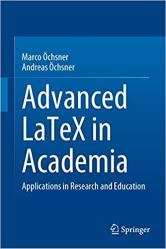Advanced LaTeX in Academia: Applications in Research and Education
- Добавил: literator
- Дата: 1-02-2022, 22:25
- Комментариев: 0
 Название: Advanced LaTeX in Academia: Applications in Research and Education
Название: Advanced LaTeX in Academia: Applications in Research and EducationАвтор: Marco Ochsner, Andreas Ochsner
Издательство: Springer
Год: 2022
Страниц: 245
Язык: английский
Формат: pdf (true)
Размер: 10.08 MB
This book contains a comprehensive treatment of advanced LaTeX features. The focus is on the development of high quality documents and presentations, by revealing powerful insights into the LaTeX language. The well-established advantages of the typesetting system LaTeX are the preparation and publication of platform-independent high-quality documents and automatic numbering and cross-referencing of illustrations or references. These can be extended beyond the typical applications, by creating highly dynamic electronic documents. This is commonly performed in connection with the portable document format (PDF), as well as other programming tools which allow the development of extremely flexible electronic documents.
LaTeX is a typesetting system that works as a high-level markup language. This means that instead of having to ‘click’ your way through formatting options and the ‘what you see is what you get’ approach many document processing programs implement, one uses a rich set of commands to specify a document’s components (titles, sections, bold font, italics, figures, among others), and lets LaTeX take care of the formatting. Of course, you can additionally personalise and further specify formatting and features of the document, which is what this book is largely about. To begin with, we will briefly review the basic structure and function of a LaTeX document. If you have used LaTeX this should all be quite familiar to you, and you might find it more useful to skip to the next chapter. A LaTeX document (a *.tex document file) is split into two main parts: the preamble and the main body of the document. The preamble contains all global specifications and formatting settings, such as paper size, font size, what kind of document it is (article, book, report, letter...). It is also where we include ‘packages’, which allow access to libraries of macros to add functionality to LaTeX. Then comes the main body of the document, often divided into different parts, chapters, or sections.
Contents:
1. Introduction: The Basics
2. Advanced Formatting
3. Floating Objects
4. Presentations
5. Exams, Tests and Quizzes
6. E-Learning: Blended Learning and Flipped Classroom Support
Скачать Advanced LaTeX in Academia
Внимание
Уважаемый посетитель, Вы зашли на сайт как незарегистрированный пользователь.
Мы рекомендуем Вам зарегистрироваться либо войти на сайт под своим именем.
Уважаемый посетитель, Вы зашли на сайт как незарегистрированный пользователь.
Мы рекомендуем Вам зарегистрироваться либо войти на сайт под своим именем.
Информация
Посетители, находящиеся в группе Гости, не могут оставлять комментарии к данной публикации.
Посетители, находящиеся в группе Гости, не могут оставлять комментарии к данной публикации.
